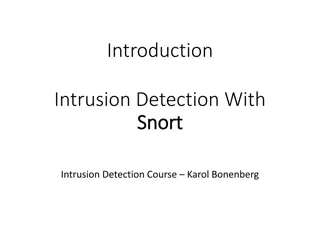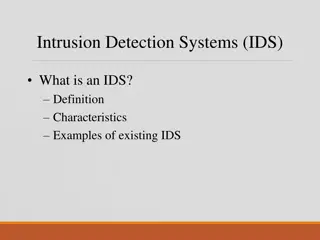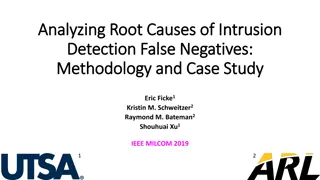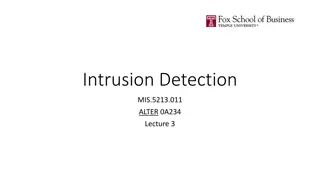Semantics-Aware Intrusion Detection for Industrial Control Systems by Mer Yksel
Mer Yksel, a PhD candidate at Eindhoven University of Technology, specializes in intrusion detection and data analytics with a focus on industrial control systems. His research covers targeted attacks, threat modeling, protection of ICS networks, and innovative anomaly-based approaches for cybersecurity. With a strong emphasis on safeguarding critical ICS assets and enhancing network security, Mer Yksel's work addresses the unique challenges posed by the industrial environment.
Download Presentation

Please find below an Image/Link to download the presentation.
The content on the website is provided AS IS for your information and personal use only. It may not be sold, licensed, or shared on other websites without obtaining consent from the author.If you encounter any issues during the download, it is possible that the publisher has removed the file from their server.
You are allowed to download the files provided on this website for personal or commercial use, subject to the condition that they are used lawfully. All files are the property of their respective owners.
The content on the website is provided AS IS for your information and personal use only. It may not be sold, licensed, or shared on other websites without obtaining consent from the author.
E N D
Presentation Transcript
Semantics-aware Intrusion Detection for Industrial Control Systems mer Y ksel Jerry den Hartog Sandro Etalle
About Me mer Y ksel PhD candidate in Eindhoven University of Technology, Security group (2014- ) Research interests: intrusion detection, data analytics
SpySpot Project Scientific Partners Industrial Partners http://security1.win.tue.nl/spyspot/
Targeted attacks Exfiltration Initial compromise Propagation Attacker Privilege escalation Sabotage
Threat Model Assets to protect: Network hosts: PLC, HMI, Control Server, Field devices: Heater, sensors, pipeline,
Threat Model System-related attacks e.g. Buffer overflow Process-related attacks e.g. Change the rotation speed Reconnaissance e.g. Map out all valid register addresses
Protection of ICS Networks Attack patterns are unpredictable. Cannot rely on signature-based systems Availability must not be impaired. Cannot use preventative systems (e.g. access control) Attacks can be carried out by sending a single malicious message. Cannot rely on flow-based detection Networks traffic contains large and diverse communication patterns. Manual whitelisting is infeasible
Protection of ICS Networks Attack patterns are unpredictable. Cannot rely on signature-based systems Anomaly detection Availability must not be impaired. Cannot use preventative systems (e.g. access control) IDS Attacks can be carried out by sending a single malicious message. Cannot rely on flow-based detection Payload-based Networks traffic contains large and diverse communication patterns. Manual whitelisting is infeasible Data-driven
Anomaly-based Approaches Payload information IP Header TCP Header Payload Src :10.10.10.11 Src:502 0a030203e8... Dst: 10.10.10.20 Dst: 50269 Network& transport header Src :10.10.10.11 Src:502 0a030203e8... Dst: 10.10.10.20 Dst: 50269 Byte string Previous work Unit id Function Par. Length Return value Src :10.10.10.11 Src:502 0x0a 0x03 0x02 0x03e8 Dst: 10.10.10.20 Dst: 50269 Protocol syntax Return value (numeric) Src :10.10.10.11 Src:502 0x0a 0x03 0x02 1000 Dst: 10.10.10.20 Dst: 50269 Protocol semantics Unit id (nominal) Function (nominal) Return value (numeric) Par. Length (numeric) Src :10.10.10.11 Src:502 Dst: 10.10.10.20 Dst: 50269 10 read (3) 2 1000 Our approach
Semantics-aware Intrusion Detection We propose a payload-based network intrusion detection framework that is: Semantics-aware Considers the protocol fields and value types in the payload. Anomaly-based Uses network traffic data to build a model of the normal traffic . General purpose Can be instantiated on any protocol where a parser is available (we test on S7 and Modbus) White-box [1] User-understandable model based on simple probabilities. Can be updated or corrected by an operator. Displays meaningful alerts. Unit id (nominal) Function (nominal) Return value (numeric) Par. Length (numeric) Src :10.10.10.11 Src:502 Dst: 10.10.10.20 Dst: 50269 10 read (3) 2 1000 [1] Costante, E., Hartog, J. den, Petkovi , M., Etalle, S., & Pechenizkiy, M. (2014). Hunting the Unknown.
General Framework Message: The PDU of an ICS-specific protocol. The messages are interpreted by external component, e.g. Wireshark protocol dissector. We focus on single- message attacks in this work.
Feature Extraction We use protocol fields to extract features from the traffic. Feature categories: Elementary: Numeric: e.g. parameter length Nominal: e.g. function, protocol identifier Compound: e.g. <function, parameter length>
Feature Selection Feature selection is performed by the expert setting up the model. Non-helpful features are discarded, such as those that are: seemingly random (e.g. nonces) sequential (e.g. counters) have an erratic behavior (displaying a high variance/entropy etc.)
Detection Model Our model of normal traffic consists of probability distributions per feature. 0.7 0.6 0.5 0.4 0.3 0.2 0.1 0 read_register write_register diagnostics Function We build the model using samples from normal traffic. 0.6 0.5 0.4 0.3 0.2 Rare values are considered anomalous. 0.1 0 0x1000 0x2000 0x4000 Register address
Profiling 0.7 0.6 0.5 0.4 0.3 0.2 0.1 0 read_register write_register diagnostics PLC-1 HMI-1 1 1 0.8 0.8 0.6 0.6 0.4 0.4 0.2 0.2 0 0 Normal traffic contains a mixture of different behavior patterns. Profiling allows detecting contextual anomalies.
Binning Numeric features tend to yield a large number of unique values. 0.6 0.5 0.4 0.3 0.2 Therefore we consider the distribution of ranges instead. 0.1 0 <5 6-10 11-15 data length
Alerts 1 0.8 Unit id (nominal) Function (nominal) IP Header TCP Header 0.6 0.4 Src :10.10.10.11 Dst: 10.10.10.20 Dst: 50269 Src:502 10 diagnostics(8) 0.2 0 read_register write_register diagnostics If a feature yields a rare value (or bin), an alert is raised. We use a threshold to determine the model s strictness. i.e. raise an alert if a value has a less than 10% probability of occurrence. The framework displays the features causing the alert.
Evaluation False Positive Rate Detection Rate
Evaluation Datasets: Modbus-RTU: Serial communication Lab setting (Mississippi State University) Preprocessed by the providers, raw traffic not available S7 Communication: Siemens devices Operational ICS Raw network traffic, parsed with Wireshark Attacks: Modbus-RTU: Reconnaissance and process-related S7: Reconnaissance and system-related attacks Publicly available at (http://descrics.com/)
Compared Approaches McPad [1] N-gram analysis Attributed token kernel [2] N-gram analysis Utilizes protocol syntax Both methods utilize one-class support vector machines (SVM) to model normal traffic. [1] Perdisci, R., Ariu, D., Fogla, P., Giacinto, G., & Lee, W. (n.d.). McPAD: A Multiple Classifier System for Accurate Payload-based Anomaly Detection, (October 2008). [2] D ssel, P., Gehl, C., Laskov, P., & Rieck, K. (2008). Incorporation of application layer protocol syntax into anomaly detection. Information Systems Security, 188 202.
Results (I) Experiments with elementary features only: S7 Modbus-RTU Approach Detection Rate False Positive Rate Approach Detection Rate False Positive Rate McPad 100% 20.2% Attributed token kernel 91% 27% Attributed token kernel 99.9% 33% White-box framework 97.3% 0.08% White-box framework 100% 0.04%
Results (II) For Modbus-RTU dataset, we create compound features using semantically related elementary features, e.g. <SetPoint, DeltaSetPoint> Approach Detection Rate False Positive Rate 97.3% 0.08% White-box framework (elementary features only) 100% 16.7% White-box framework (w/ compound features) 100% 0.57%
Alert causes Features causing majority of the alerts in the detected attacks: Modbus-RTU Time Interval Pipeline pressure Set point S7 Data length ROSCTR (Remote operating service control) Parameter count Function
Performance Time complexity: Training: Linear to the dataset size Detection: constant time Can be scaled to larger networks by utilizing profiling. Parsing is the main bottleneck in the current implementation. Processing a single message: 0.97msec Parser overhead: 0.7msec
Conclusions N-gram analysis is not practical on binary protocols. Utilizing the right features is more important than creating a complex model of normal behavior. Using a simple model allows a human operator to correct and update the model, and results in alerts containing actionable information.
Visualization Integration with a visual interface for displaying alerts and traffic in detail and updating the model. Bram Cappers <b.c.m.cappers@tue.nl> https://www.youtube.com/watch?v=aYywTOYjYDA
Future Work Feature selection Metrics of feature quality Designer interface Feature construction Application to other domains Back office traffic Detection of sequential attacks Looking at sessions or groups of messages
Thank you o.yuksel@tue.nl Project: http://security1.win.tue.nl/spyspot/
Tuning Human operator can update the model by modifying bins or thresholds.























